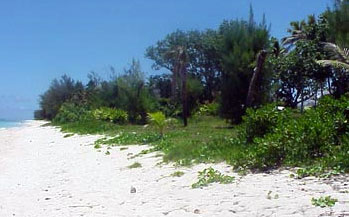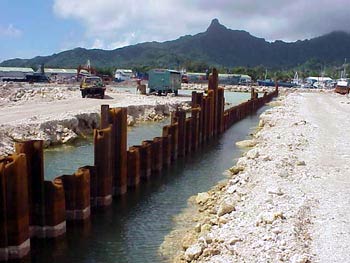 |
Vaitoti Tupa discusses the environmental challenges facing the Cook Islands, commenting on climate change and sea-level rise, resource sustainability and capacity building. |
| The author is director of the National Environment Service of the Cook Islands. | |
The Cook Islands has rights and responsibilities over 1.8 million square kilometres of ocean. This area is of considerable ecological, economic, social, scientific and cultural importance. The coastal areas, lagoons and those waters within the three nautical mile zone are directly affected by land-based and inshore activities, thus, although the coastal and outer areas fall under the jurisdiction of the Ministry of Marine Resources, the Environment Service and other institutions have an important role to play.
The Cook Islands oceans and coastal area are in relatively good condition on an international scale. They have, however, experienced localized degradation in coastal environments, aggravated by externally-driven events such as coral bleaching. The ocean and coastal systems are under increasing demands from many users, such as commercial and subsistence fisheries, shipping, tourism and recreational activities. These activities give rise to significant environmental pressures, such as those from tourism infrastructure development, fisheries bycatch and introductions of invasive marine species. The impact of run-off from urban and agricultural activities places substantial stress on the marine environment.
The key burning national ocean issues in a regional context are:
- climate change and sea-level rise;
- sustainability of resources; and,
- capacity building.
Like many other Pacific Islands, the Cook Islands is vulnerable to environmental, economic and social circumstances. Particular threats include: environmental - climate change and sea-level rise, limited freshwater resources; economic - high import dependencies, fluctuating world prices for commodities; and social - human and food security, cultural dilution and loss of traditional knowledge and practices.
Long-term environmental damage to the lagoon ecosystem from unplanned development, as well as increasing nutrient seepage from septic tanks into ground water lenses and into the lagoon, is alarming. Disposal of white-wares, rubbish, motor vehicles and motor vehicle parts is a major environmental concern. The impact of these issues needs to be continually monitored and managed.
Capacity building remains a national priority across the marine environment sector: particularly in the areas of climate change awareness and adaptation measures, biodiversity conservation, disaster mitigation and environmental monitoring in general.
Sea-level rise, changes in storm intensity and frequency, temperature, precipitation and storm surges are components of climate change that will potentially have a great impact on the coastal area over the coming years. This could be devastating for the Cook Islands, as all of the population is dependent on the coastal areas in one way or another. Rising sea levels could inundate low-lying areas, erode shores and increase saltwater intrusion into ground water supplies to which much of the Cook Islands is already vulnerable.
 |
Recent years have seen an increase in both the intensity and frequency of extreme climate events. Cyclone Sally extensively damaged Rarotonga in January 1987. In November 1997, Cyclone Martin destroyed 90 per cent of the houses and killed 19 people on Manihiki atoll. Since 1998, the Cook Islands has experienced more intense storms, flooding and wave surges, damaging coastal infrastructure. In January 2004, Cyclone Heta induced a storm surge causing significant foreshore damage despite "missing" the Cook Islands. Cyclones can severely damage infrastructure associated with fishing, including ports and breeding areas. Storms are also a major threat to the safety of fishermen.
Coral reefs provide natural breakwaters for Cook Islands coastlines and will become increasingly important for storm protection as the sea level rises. All islands are experiencing coastal erosion, and changes in intensity or frequency of storms are likely to worsen these problems. Although it is not likely that all of the Cook Islands would disappear under the sea even with the highest projected rates of sea-level rise, the effectiveness of the reefs in protecting coasts might be affected.
Due to the relationship of coral reefs to light, temperature, salinity and sea level, corals and reefs have long been regarded as vulnerable to climate change. Coral will inevitably be among the organisms to show the consequences of sustained increases in sea surface temperature. In the Cook Islands, there has been bleaching of coral associated with El Niño disturbances. The question remains whether reefs will keep up, catch up or give up with climate change and sea-level rise and this is related to how healthy the reefs are presently.
The coastal zone is the base for sustaining livelihoods and economic development for Cook Islanders. Coastal degradation and erosion are a major concern for the Cook Islands' primary industry, tourism, which relies heavily on the idyllic lagoon and white sand beach imagery. In an effort to be proactive and not reactive, the Cook Islands government is simultaneously implementing several regional projects, which tackle climate change adaptations, capacity building, impact assessments, hazards and risk management. These aim to improve Cook Islanders' ability to cope with climate-related risks at the national and community level. Outcomes required are increased awareness of climate change and sea-level rise impacts, adaptation options that can be mainstreamed at the national level, and ways that communities can work together to lessen potential impacts. A regional ocean policy should reinforce and sustain such steps.
Cook Islands marine industries (aquaculture, tuna long-line fisheries, marine tourism) have been growing steadily over the past decade. Both the aquaculture and tuna industries are export-oriented, and all three marine industries are major providers of jobs.
As part of the United Nations Convention of the Law of the Sea, Cook Islands has rights to explore, harvest, manage and conserve the natural resources within its Economic Exclusion Zone. With these rights are obligations under regional/international conventions, treaties, arrangements and agreements dealing with matters such as fisheries, shipping, biodiversity, pollution and conservation of cetaceans. The Cook Islands has maritime boundaries with five nations, Kiribati, Niue, the United States, New Zealand and France.
The Ministry of Marine Resources in collaboration with the Ministry of Transport and the Environment Service manages the Cook Islands' oceans including enclosed and semi-enclosed seas. The Ministry of Marine Resources' focus is on economic management of the oceans and inshore and coastal areas, while the Ministry of Transport administers the Marine Pollution Prevention Act that prohibits the dumping and transportation of waste in Cook Islands waters. The marine pollution programme provides legal and administrative elements for the appropriate administration and management of shipping (including fishing vessels) in terms of the safety of life and property at sea and the preservation of the marine environment. It includes the establishment of legislative frameworks for ratifying United Nations conventions and treaties.
The Ministry of Marine Resources has focused on the pearl industry in the Northern Islands of Manihiki, Penrhyn and Rakahanga. Developments in the pearl industry have produced mixed results, including the Penrhyn Marine Research Centre and the establishment of a lagoon monitoring programme with information being disseminated to all stakeholders. Information from the monitoring programme focuses primarily on parameters that are significant for pearl production. The Cook Island pearl industry has experienced high mortalities due to environmental extremes and localized overcrowding.
 |
The long-line fishing and the fishing industry generally have developed in recent years, with mostly foreign-owned and operated fishing vessels. The establishment of three medium- sized pack-house facilities provides support for processing value-added products locally.
The fish corals and lagoons are among the nation's major assets supporting the tourism sector. Care is required in reef and lagoon management to ensure that their biodiversity is preserved and they remain attractive for diving and snorkelling.
Poor reef health is usually a result of human byproducts and activities. In addition, the lagoon ecosystem that supports the coral reefs has already been stressed. Sedimentation accumulation from past agriculture run-off threatens both native clams and corals. Such stressed reef habitats provide opportunities for ciguatera dinoflagellate organisms to colonize the coral surfaces, making the reef fish that feed on it poisonous for people. Disturbed reefs tend to also be associated with concerns like crown of thorn starfish outbreaks.
At the regional level, the challenge for the Ministry of Marine Resources is the articulation of Cook Islands issues and interests in relation to the Commission for the Conservation and Management of Highly Migratory Fish Stocks.
Capacity building in the application and use of expert systems and technical tools to decision-making and planning exercises remains a priority for the Cook Islands. Sustainable use of the country's limited resources and maintaining biological diversity is a concept yet to be fully grasped by government and its partners. National and local governments, traditional leaders and the Cook Islands community are essential in the development of integrated approaches to the planning, development and management of the ocean/coastal marine environment.
Primary needs for capacity building are in the area of institutional arrangements and both technology and expertise for ongoing monitoring programmes. Environmental issues and the need to protect and preserve the environment are well supported by the people of the Cook Islands as long as processes are not politicized. Politicization caused a delay in passing the national 2003 Environment Act.
Challenges facing the Environment Service include the continuation of community education on the merits of protecting the environment without compromising their rights as traditional landowners and undermining traditional conservation practises and customs. Current issues stem from a general lack of - if not, insufficient - resources within the service, non-government environment groups and the community at large.
The Cook Islands Vulnerability and Adaptation Assessment for coastal areas found that, while different islands' profiles varied greatly, if there is community understanding and support, backed up by consistent local government policy, adaptation responses are possible. This is important, as the coastal areas in the Cook Islands provide a good quality of life, customary tenure and a measure of happiness. Retreat will not be an option, even in the face of accelerated sea-level rise and climate changes.
Acknowledgements
This article is based on the Statement by the Cook Islands Delegation presented by Vaitoti Tupa at the Pacific Islands Regional Ocean Forum at the University of the South Pacific, Suva, Fiji, in February 2004.
Further information
Vaitoti Tupa, National Environment Service, Government of the Cook Islands, PO Box 371, Rarotonga, Cook Islands. Fax: +682-22256. Email: vaitoti@environment.org.ck. Web: www.environment.org.ck.
On the Web
The website of the Pacific Islands Regional Ocean Forum contains statements by other delegations, conference proceedings and background papers. An overview of the Cook Islands Vulnerability and Adaptation Assessment is available (5.9Mb download). The Tiempo Climate Cyberlibrary maintains a listing of key websites covering small island developing states.